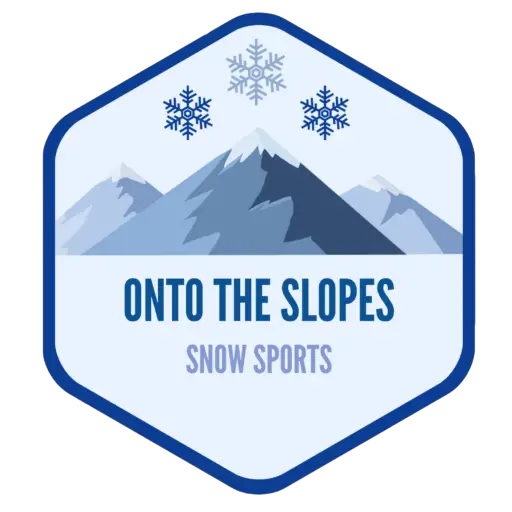Ski slope ratings can be very confusing to get your head around if you’re skiing in resorts in different parts of the world. So, I’ve created this guide to European and North American ski slope difficulty classifications to help simplify the grading systems.
Euro and American Ski Slope Rating 101
In Europe, the pistes are categorised by color whereas in North American they are named according to a color and shape.
The ski slopes in Europe are graded as follows from easiest to hardest: green, blue, red and black. In North America the grades from easiest to hardest are as follows: green circle, blue square and black diamond.
Hence the main difference between the North American and European grades are that only European countries use the color “red”.
In North American Ski resorts, the easiest slopes are classified as “green circle”. In France, Spain and the UK the easiest slopes are classified as “green” whereas in Austria, Switzerland and Italy the easiest slopes are “blue”.
In North America, “blue square” slopes are designed for intermediate-level skiers, whereas in Europe they are red or blue. In Austria, Switzerland and Italy, the red slopes are similar to the blue square slopes in North America. In France, Spain and the UK, these slopes are more comparable to the hardest blue slopes or easiest red slopes.
The most difficult slopes in North America are black diamond, double black diamond and triple black diamond. The most difficult slopes in Europe are black, double black and triple black. North American black diamond slopes are similar to the hardest red slopes and easiest black slopes in Europe.
| North American Grade | European Grade | Average Gradient |
| Green Circle | Green and Blue | <25% |
| Blue Square | Red | 25-40% |
| Black Diamond | Black | >40% |
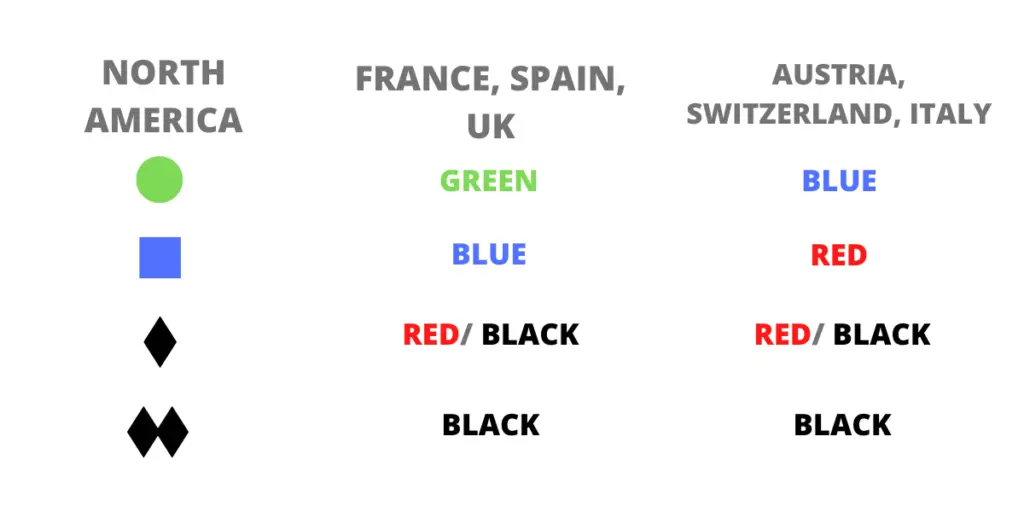
European Ski Slope Grades Explained
Slope Difficulty in Europe (Least to Most):
- Green
- Blue
- Red
- Black
- Double Black
- Triple Black
- Orange
- Yellow
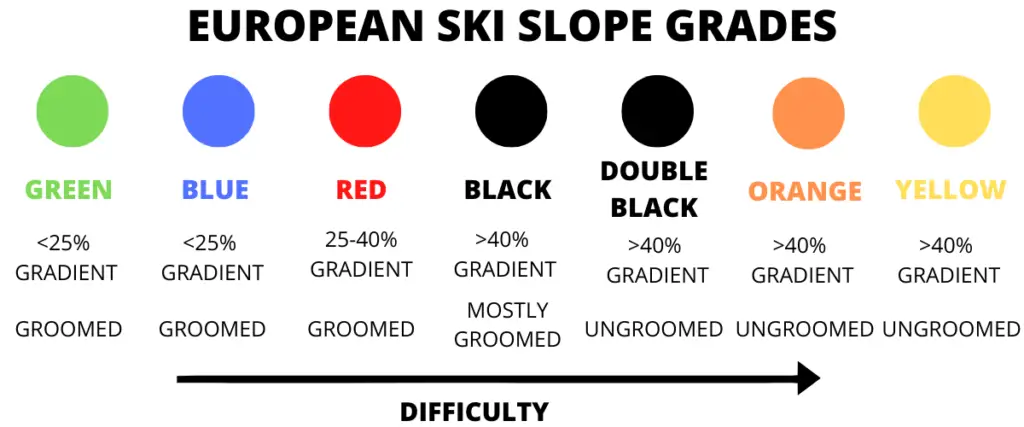
Green Slopes
Green classified pistes are designed for beginners in most European countries. The only exceptions are Austria and Switzerland which do not have any green slopes and instead start with blue slopes. Green slopes are always groomed and are wide and shallow with a gradient of less than 25%.
Blue Slopes
Blue pistes are designed for beginners-intermediates in Austria and Switzerland. In other European countries such as France and Italy blue slopes are more difficult than green slopes and are designed for intermediate skiers.
Blue pistes have a gradient of roughly 25% (similarly to the most difficult green runs) and are groomed.
Red Slopes
Red slopes are are designed for advanced skiers in Europe. The gradient is between 25% and 40% making them much steeper than blue and green slopes and are also usually narrower. Red slopes are groomed in European resorts.
Black Slopes
Black slopes are designed for expert skiers in Europe with a high level of experience. They have a gradient of over 40% and are groomed in most European countries except for France where only some are groomed.
Double and Triple Black Slopes
Double and triple black slopes are mostly limited to Scandinavian resorts and are extremely difficult and designed for the most experienced and skilled skiers. Triple black slopes are more difficult than double black slopes.
Orange and Yellow Slopes
Orange slopes are mostly limited to Austria and Switzerland and are very difficult and more advanced compared to black slopes. Yellow ski runs are quite rare but mark the most dangerous routes because they are off-piste (un-groomed).
North American Ski Slope Grades Explained
Slope Difficulty in North America (Least to Most):
- Green Circle
- Blue Square
- Black Diamond
- Double Black Diamond
- Triple Black Diamond/ Orange Diamond
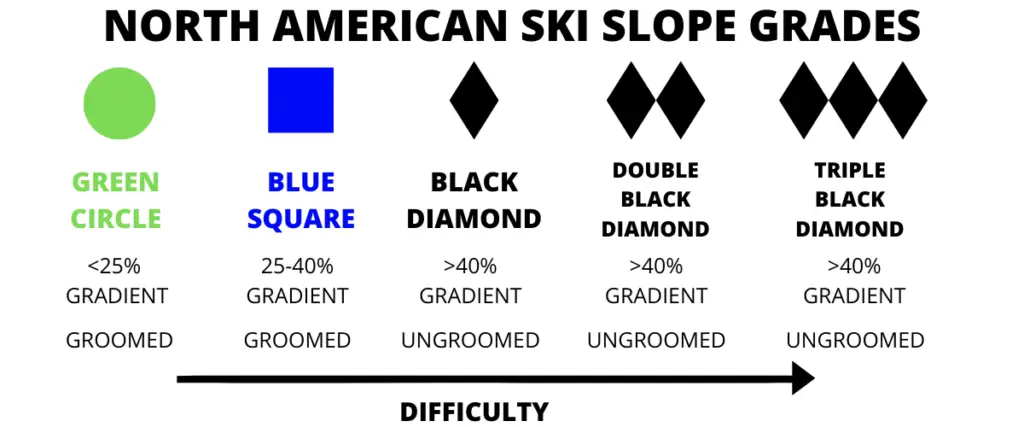
Green Circle
In Canada and the USA, green circle routes are the easiest and designed for beginners. They are wide and shallow and have a gradient of less than 25%. Prerequisites for green circle runs include the wedge technique to slow down turns.
Blue Square
In North America, blue square slopes are designed for intermediate skiers and have a gradient of 25%-40% making them steeper and faster compared to green circle pistes. To use a blue run, skiers should be comfortable with all green circle runs and be confident stopping quickly and performing parallel turns.
Black Diamond
Black Diamond routes have a gradient of over 40% and are designed for advanced skiers with a high level of experience. These routes may be ungroomed and are usually very narrow and have trees.
Check out my comparison between Blue Square and Black Diamond slopes for more information.
Double/ Triple Black Diamond
Double and Triple Black Diamond runs are the most difficult in most North American ski resorts. They should only be attempted by experts as they are very steep, narrow and have cliffs. Triple Black Diamond routes are the most challenging.
Orange Diamond
Orange Diamond routes are rare and only seen in some resorts. They are more difficult than Double Black Diamond routes and similar to Triple Black Diamond routes.
Japanese Ski Slope Grades Explained
Slope Difficulty in Japan (Least to Most):
- Green
- Red
- Black
Japanese resorts follow a fairly similar system to North America and Europe when it comes to ski slope grading. The easiest routes designed for beginners are typically “green slopes”. Most slopes are red which are designed for intermediates whilst the black slopes are the steepest and most advanced.
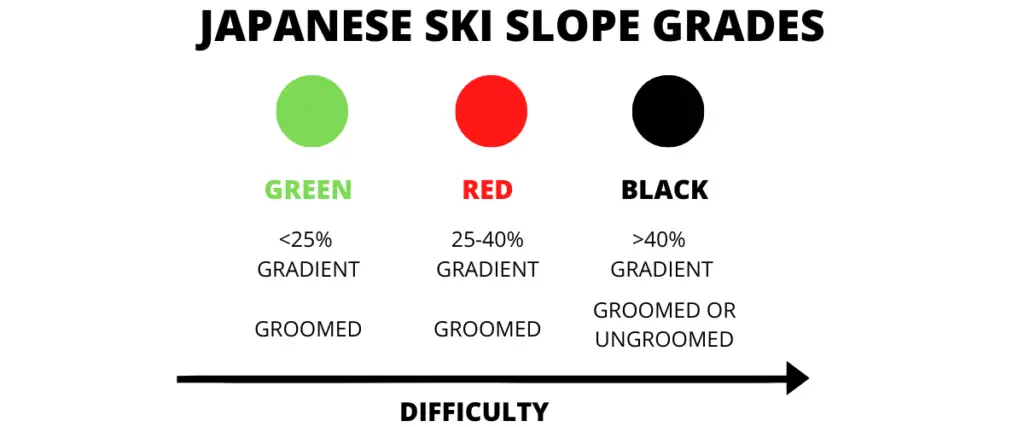
How are Slopes Graded?
There is no universal system for grading ski slopes in North American, Europe or Japan. This means that a set of blue square slopes in one resort is not necessarily the same difficulty as a set of blue square slopes in another resort. There is also variation within each category within the same resort.
However, all resorts will consider the gradient, width, obstacles and whether the route is groomed or not when classifying the slope so there is still a loose system to consider.
Gradient
One of the easiest way to grade ski slopes is according to the gradient, with the shallowest pistes being the easiest and the steepest of course being the most difficult. Here’s a general guide to the gradient and which classification it fits into in most resorts.
| Gradient | North American Grade | European Grade |
| <25% | Green Circle | Green and Blue |
| 25-40% | Blue Square | Red |
| >40% | Black Diamond, Double/ Triple Black Diamond, Orange Diamond | Black, Double/ Triple Black, Orange and Yellow |
Groomed vs Ungroomed
A groomed ski slope is easier to ski on as there is less chance of moguls forming and the surface is more even.
In most resorts, green, blue and red slopes are groomed. Some black/ black diamond routes are groomed and others are not. Double/ triple black and black diamond, orange and yellow routes are not groomed.
Width and Obstacles
The easiest green routes are wider and do not have obstacles making them much easier to ski on. As the difficulty increases, the width of the slope is usually decreased giving the skier less margin for error when turning. Black routes also typically have more obstacles such as trees to negotiate.
